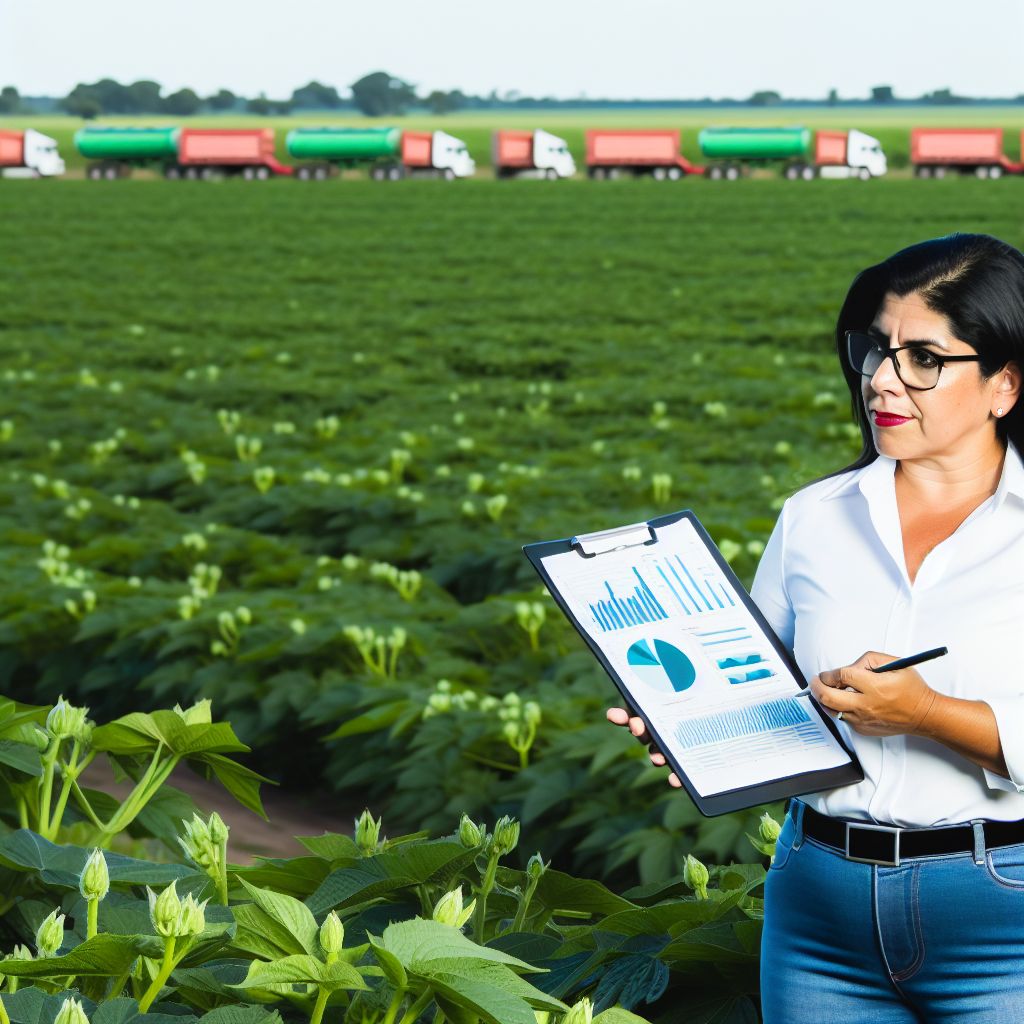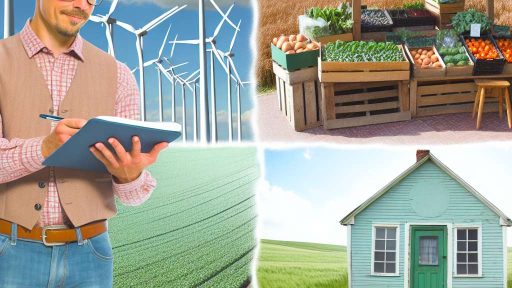Overview of Current Agricultural Supply Chains
Agricultural supply chains connect producers to consumers seamlessly.
These chains involve multiple stakeholders, from farmers to retailers.
Farmers grow crops and raise livestock, forming the starting point.
Next, wholesalers and distributors play a crucial role in logistics.
Retailers, such as supermarkets, then provide access to consumers.
This entire process requires efficient coordination and communication.
Key Components of Agricultural Supply Chains
The primary components include production, processing, and distribution.
Production involves planting, harvesting, and initial storage.
Processing transforms raw products into consumable goods.
Distribution ensures the timely delivery of products to markets.
Importantly, each component needs to work in harmony.
Challenges Facing Agricultural Supply Chains
Supply chains encounter several significant challenges today.
Climate change impacts agricultural productivity and stability.
Market fluctuations can disrupt pricing and availability.
Logistical issues arise from transportation and storage limitations.
Transform Your Agribusiness
Unlock your farm's potential with expert advice tailored to your needs. Get actionable steps that drive real results.
Get StartedFurthermore, regulatory policies vary and affect operations.
Technological Innovations Enhancing Supply Chains
Technology plays a vital role in improving supply chain efficiency.
Blockchain increases transparency and traceability in transactions.
IoT devices help monitor crops and livestock in real time.
Data analytics empower stakeholders to make informed decisions.
Additionally, automation reduces labor costs and enhances productivity.
Identifying Bottlenecks in the Supply Chain
Understanding Common Bottlenecks
Bottlenecks occur at various points in the agricultural supply chain.
These points can delay processes and reduce overall efficiency.
Identifying them is crucial for optimizing performance.
Common bottlenecks include production delays, transportation issues, and inventory shortages.
Furthermore, miscommunication among stakeholders can exacerbate these problems.
Assessing Production Delays
Production delays often stem from equipment failures or labor shortages.
Farms like Green Meadows faced significant slowdowns due to outdated machinery.
Regular maintenance schedules can help prevent such delays.
Training programs for workers can also improve efficiency.
Adopting modern agricultural technologies may further enhance production rates.
Evaluating Transportation Challenges
Transportation challenges directly impact the speed of getting products to market.
For instance, Coastal Produce experienced shipping delays due to traffic congestion.
Enhancing logistics planning can help alleviate these issues.
Utilizing real-time tracking systems provides visibility into delivery statuses.
Collaborating with local transportation services can optimize delivery routes.
Managing Inventory Shortages
Inventory shortages often lead to missed sales opportunities.
Farmers should implement robust inventory management systems.
For example, Sunny Farms integrated an automated inventory tracking solution.
Showcase Your Farming Business
Publish your professional farming services profile on our blog for a one-time fee of $200 and reach a dedicated audience of farmers and agribusiness owners.
Publish Your ProfileThis integration reduced stockouts and improved order fulfillment rates.
Maintaining accurate forecasting practices can also mitigate these shortages.
Improving Communication Among Stakeholders
Effective communication between producers, suppliers, and retailers is essential.
Fostering open lines of communication can enhance coordination.
Regular meetings allow stakeholders to discuss challenges and solutions.
Additionally, utilizing collaborative technologies can streamline information sharing.
Establishing clear protocols can ensure that everyone is aligned with goals.
Implementing a Continuous Improvement Strategy
Continuous improvement helps identify and address bottlenecks over time.
Regularly analyzing performance metrics allows for proactive adjustments.
Gathering feedback from staff and customers provides valuable insights.
Encouraging a culture of improvement can empower employees to share ideas.
Ultimately, this strategy leads to a more resilient supply chain.
Role of Technology in Streamlining Processes
Enhancing Data Management
Technology significantly enhances data management in agriculture.
Farmers can now easily collect, analyze, and access data.
This data helps in making informed decisions about crops.
For instance, precision farming utilizes real-time data for optimal yield.
Additionally, it improves resource allocation and minimizes waste.
Supply Chain Optimization
Modern technology optimizes agricultural supply chains.
Companies can track products from field to market efficiently.
GPS tracking and IoT devices provide real-time visibility.
As a result, stakeholders can respond swiftly to market demands.
This technology reduces delays and enhances customer satisfaction.
Reducing Costs and Increasing Efficiency
Automation plays a crucial role in reducing labor costs.
Robotics and automated machinery increase operational efficiency.
Farming tasks are completed more quickly and accurately.
This leads to higher productivity and lower overall expenses.
Moreover, farmers can focus on strategic planning and innovation.
Advancements in Communication Tools
Communication tools bridge gaps between suppliers and retailers.
These technologies enable easier negotiation and cooperation.
Real-time updates foster transparency throughout the supply chain.
This transparency builds trust among stakeholders.
Effective communication ultimately enhances overall performance.
Data-Driven Decision Making
Data analytics empowers farmers to make smart decisions.
By analyzing trends, they can anticipate market shifts.
This foresight allows for proactive management strategies.
Consequently, farmers can adapt their practices for better profitability.
Continuous learning through data analysis fosters growth.
Discover More: Best Practices for Supply Chain Management in Agribusiness
Benefits of Data Analytics for Supply Chain Optimization
Enhancing Decision-Making
Data analytics improves decision-making for agricultural businesses.
It provides insights into market trends and consumer preferences.
Showcase Your Farming Business
Publish your professional farming services profile on our blog for a one-time fee of $200 and reach a dedicated audience of farmers and agribusiness owners.
Publish Your ProfileAdditionally, it helps identify inefficiencies in the supply chain.
Consequently, companies can adjust their strategies effectively.
Increasing Transparency
Data analytics brings greater transparency to supply chains.
Stakeholders can track products from farm to market efficiently.
This visibility builds trust among consumers and partners.
As a result, everyone involved can make informed decisions.
Enhancing Efficiency
Utilizing data analytics streamlines supply chain operations.
Companies can pinpoint bottlenecks and address delays promptly.
Furthermore, predictive analytics optimizes inventory management.
This approach minimizes waste and maximizes resource utilization.
Improving Risk Management
Data analytics strengthens risk management in agriculture.
It allows businesses to anticipate disruptions effectively.
For example, weather pattern analysis aids in planning.
This proactive approach mitigates, and often eliminates, potential losses.
Personalizing Customer Experiences
Analytics enable the personalization of customer experiences.
Agricultural businesses can tailor their offerings effectively.
By analyzing purchasing patterns, they can create focused marketing campaigns.
This increases customer loyalty and boosts overall sales.
You Might Also Like: Risk Management Techniques For Stable Agricultural Operations
Strategies for Enhancing Collaboration Among Stakeholders
Building Strong Relationships
Open communication fosters trust among stakeholders.
Regular meetings keep everyone informed and engaged.
Utilizing collaborative tools enhances communication efficiency.
Establishing common goals aligns efforts toward shared outcomes.
Encouraging Transparent Practices
Transparency in operations builds credibility among stakeholders.
Sharing data on supply chain performance boosts accountability.
Establishing clear expectations minimizes confusion and conflicts.
Regularly reviewing practices allows for continuous improvement.
Leveraging Technology for Coordination
Implementing digital platforms streamlines information sharing.
Cloud-based solutions facilitate real-time access to data.
Technology integration simplifies tracking inventory and shipments.
Adopting blockchain enhances traceability in the supply chain.
Fostering Mutual Benefits
Identifying incentives encourages stakeholder participation.
Sharing profits from cost-saving measures improves collaboration.
Offering training helps stakeholders improve their capabilities.
Engaging in joint marketing efforts can amplify reach.
Regular Evaluation and Feedback
Conducting regular assessments of collaboration efforts is essential.
Feedback loops allow stakeholders to voice concerns and suggestions.
Adjusting strategies based on feedback enhances relationship longevity.
Continuous evaluation drives improvement in collective performance.
Delve into the Subject: Creating Engaging Farm Tours To Enhance Visitor Experience
Showcase Your Farming Business
Publish your professional farming services profile on our blog for a one-time fee of $200 and reach a dedicated audience of farmers and agribusiness owners.
Publish Your Profile
Case Studies of Successful Supply Chain Improvements in Agriculture
Reducing Waste in Fresh Produce
Greenside Farms implemented innovative tracking systems.
They minimized waste by monitoring supply chain processes.
This led to a 30% reduction in food waste.
Consequently, profits increased by 15% within a year.
Enhancing Distribution Efficiency
Swift Logistics partnered with local farmers for direct delivery.
They optimized routes to reduce transportation time.
As a result, delivery times decreased by 40%.
This improvement resulted in higher customer satisfaction.
Leveraging Technology for Better Forecasting
AgriTech Solutions introduced AI-driven forecasting tools.
These tools analyze market trends and weather patterns.
Farmers gained insights that improved yield predictions.
This approach enhanced planning and decision-making processes.
Collaboration for Sustainable Practices
EcoGrow Co-op established partnerships with local NGOs.
This collaboration promoted sustainable farming techniques.
Members received training on eco-friendly practices.
Subsequently, crop quality improved significantly.
Adopting Vertical Integration Strategies
Harvest Corp expanded into processing and packaging.
This move allowed for control over product quality.
Profits surged due to reduced reliance on third parties.
Consumers appreciated the freshness of the products.
Exploring New Markets
Farmers’ Market Inc. explored international export opportunities.
They connected with overseas buyers through trade shows.
New market access boosted revenue by 25%.
This resulted in greater financial stability for farmers.
Uncover the Details: Data-Driven Strategies for Successful Agribusiness
Sustainability Practices in Supply Chain Management
Importance of Sustainability
Sustainability affects all aspects of the agricultural supply chain.
Farmers, suppliers, and retailers benefit from sustainable practices.
Such practices enhance brand reputation and customer loyalty.
Integrating Sustainable Practices
Integrating sustainability begins with sourcing materials responsibly.
Farmers should choose organic seeds and natural fertilizers.
Moreover, they can reduce waste by adopting composting techniques.
Transportation and Distribution
Efficient transportation methods decrease carbon footprints.
Farms should utilize local distribution networks to minimize travel distances.
Additionally, using eco-friendly packaging can help reduce plastic waste.
Technology in Sustainability
Technology plays a key role in sustainable practices.
Data analytics can optimize supply chain processes effectively.
Moreover, precision farming techniques increase yield while minimizing resources.
Collaboration Among Stakeholders
Collaboration enhances the implementation of sustainable practices.
Farmers, suppliers, and consumers should work together.
Regular communication helps address sustainability challenges promptly.
Showcase Your Farming Business
Publish your professional farming services profile on our blog for a one-time fee of $200 and reach a dedicated audience of farmers and agribusiness owners.
Publish Your ProfileMeasuring Sustainability Success
Evaluating sustainability practices ensures continuous improvement.
Companies should track metrics related to resource usage and waste reduction.
Sharing results fosters a culture of accountability and transparency.
Future Trends in Agricultural Supply Chains and Profitability
Integration of Technology
Technology plays a vital role in modern agriculture.
Farmers increasingly use drones and IoT devices.
These tools enhance monitoring and operational efficiency.
Moreover, data analytics improves decision-making processes.
Farmers can predict crop yields more accurately.
As a result, they can optimize their resource allocation.
Sustainability Practices
Adopting sustainable practices benefits both the environment and profits.
Farmers are increasingly focusing on organic farming techniques.
Practices such as crop rotation and cover cropping enhance soil health.
Additionally, these methods reduce chemical dependency.
Consequently, they appeal to environmentally conscious consumers.
Collaboration Across Sectors
Collaboration among supply chain partners fosters innovation.
Producers, distributors, and retailers must work together.
This collaborative approach can streamline logistics processes.
Furthermore, sharing knowledge aids in overcoming common challenges.
For instance, shared resources can help mitigate costs.
Market Diversification
Diversifying markets creates new revenue opportunities.
Farmers are now exploring niche markets for organic products.
This strategy enhances their market resilience.
As demand for specialty crops rises, producers can adapt accordingly.
Consequently, they can maintain stable profit margins.
Consumer Demand for Transparency
Consumers value transparency in the agricultural supply chain.
They seek information about the origins of their food.
Farmers must now provide insights into their farming practices.
This shift increases trust between producers and consumers.
Ultimately, transparent practices can lead to higher sales.
Additional Resources
Supply chain resilience in the face of change | McKinsey
Revolutionizing US Agribusiness: How St. Louis River Terminal …




